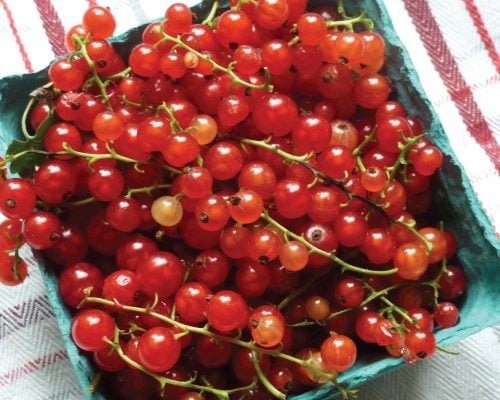
Learning Download: How to Grow Currants
From Seed to Harvest: A guide to growing currants.
Currants are a type of berry that comes in red, black or white colors. They grow on small shrubs. Currants are a hardy, easy-to-grow berry that foes well in pies, jams or pastries. Currants are native to North America.
To plant:
Currants are self-pollinating, so multiple plants aren’t necessary to produce fruits. Currants should be planted in the early spring. To prepare a site for planting, add a layer of compost and dig it into the soil. Dig a hole two times as big as the currant’s root ball, and loosen the soil at the bottom of the hole. If the currant bush has shoots, cut them back 6 to 10 inches before planting. Space plants 4 to 5 feet apart in rows set 6 feet apart. Water the newly planted currants with a slow trickle for 60 to 90 minutes.
To grow:
Currants grow best in partial or full sun. Adding mulch can help retain moisture and deter weeds. Currants should be pruned in the early spring following the first year. For the first year of pruning, prune everything but six to eight shoots. The second year pruning, remove all but four or five healthy shoots that are one-year old and three or four healthy shoots that are two years old. Every year following, prune so that four to five shoots remain that are one year old, and three to four shoots remain that are older. Any branches older than three years old should be removed as well.
To harvest:
Currant plants typically aren’t ready to harvest for a year after planting, but 2-year old plants should produce flowers and berries. One currant bush can produce up to 10 pounds of berries per season. Currants have various colors, so pick them two to three weeks after they have turned the color they are supposed to be, which could be white, black or red. To harvest, pick the entire sprig and pull off the individual berries later. Dry the berries off after picking them because they mold quickly. Store fresh currants in the fridge for up to four days. If you freeze the whole berry, they can be kept good for several months.
What currants crave:
Feed currants once a year, usually in the spring. Use a potassium-rich fertilizer. For natural fertilizers, use a seaweed-based one. When mulching around the currants, add some pine needles. This will add natural acidity, which currants need.
Where to buy currants plants:
You can find currant seeds and plants at Urban Farmer.
Learning Download: Common pests and diseases: Currants
Common pests and diseases: Currants
When growing fruits and vegetables, it is always exciting to care for the plant throughout its growing phase and then harvest it for delicious recipes later on, but one thing to watch out for is pests and diseases. Different plants are susceptible to different types of pests and diseases, and it is important to make yourself aware so you can keep a watchful eye and also take any preventative methods to keep your plants safe throughout their lifespan.
Currants can fall victim to several different pests and diseases.
Pests:
Some of the most common pests affecting currants include birds, aphids and big bud mites.
Birds will completely destroy the plant’s developing fruit and the only tried and true way to prevent birds from completely ridding your plants of the currants is to cover the plants with a fruit cage.
Aphids are small insects that target the plant by sucking the liquid out of the new shoots. This will weaken the bush as a whole. The aphids also create a sticky liquid that covers the leaves. This sticky liquid then attracts other pests and insects. Although it is rare for aphids to kill the currant bush, they can decrease the amount of fruit produced by a substantial amount. Aphids will typically occur on the bushes from late April to May. Treat the aphids at the first sign of infestation by spraying them.
A big bud mite is a pest that almost exclusively affects currant plants. When buds begin to form in the late winter, the affected buds will become much larger and fall from the plant. There is no cure, just wait for the harvest season, harvest whatever is produced and then dig up the plant and burn it.
Diseases:
Some of the most common diseases affecting currants include anthracnose, leaf spot, powdery mildew and more.
Anthracnose is a fungus infestation that will cause dark brown or black dots on the surfaces of the currant’s leaves. This infection may occur at any time during the growing season, and the spots will enlarge. Infected leaves can turn yellow and then drop from the plant. The dropping leaves can weaken the plant and may result in smaller fruit of a worse quality.
Leaf spot will cause larger spots than anthracnose, and it will normally occur in June. Small black specks will scatter across the leaves. The infected leaves will turn yellow and drop off the plant.
Powdery mildew will cause white patches of fungus on the lower parts of the plant and then they will occur on the branches, leaves and fruits. This can cause stunting and lower fruit production. Plant resistant varieties to decrease the likelihood of this affecting your plants.

